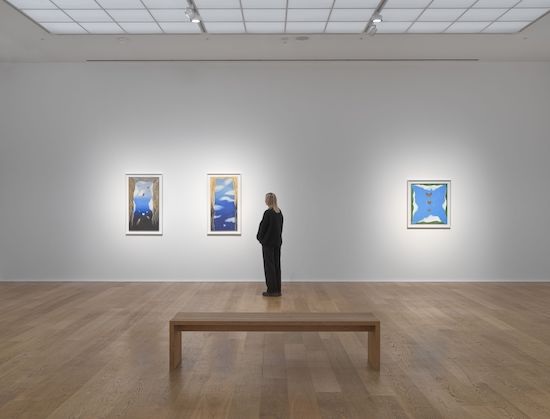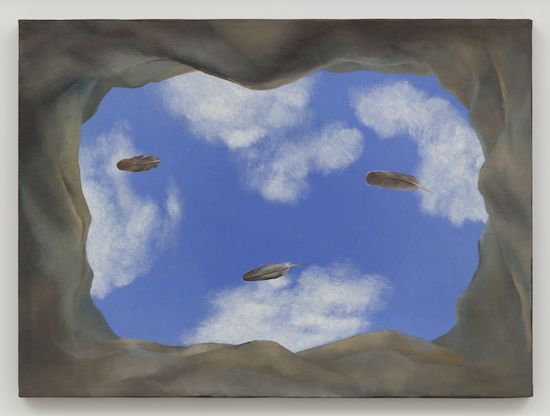Luchita Hurtado, Untitled, c. 1976, Oil on canvas, 42.5 x 58.4 cm / 16 3/4 x 23 in. © The Estate of Luchita Hurtado
Courtesy The Estate of Luchita Hurtado and Hauser & Wirth
Photo: Jeff McLane
Hauser and Wirth’s exhibition of previously unseen works from Luchita Hurtado’s Sky Skin series is a punchy reminder of the grace and power women’s bodies hold. Viewers are met with a mix of brightly lit skies and dusty sandscapes, each lightly punctuated with floating feathers, butterflies or pebbles. These artworks are deceitful in their simplicity. The canvases act as windows into Hurtado’s world, and through delving a little deeper, we begin to understand how each image captures a vital facet of the artist’s life. Harnessing both humour and aggression, this brief insight into Hurtado’s practice acts as a microcosm for her entire artistic career – one that consistently explored feminism, transcendence and earth’s spirituality across a range of multimedia.
“We’re all voluptuous. The fruit we eat, the life we live, having children, the happiest of families. The themes in my works go way back. The pleasures of life, times of stress…”
This quote comes from Hurtado’s 2020 exhibition at The Serpentine, I Live I Die I Will Be Reborn (tail-ending the immense wave of ‘re-discovery’ that Hurtado’s oeuvre went through before her death in the same year). Though the quote refers to a different set of paintings from those shown at Hauser & Wirth, such works are vital in understanding Hurtado’s continual interrogation of the politics, curves and beauty of the female body.
“I am very sensual; I love smells and tastes. I love fruit, you see. Religion is full of fruit. And an apple means more than an apple!”
Throughout her life, Hurtado was an active feminist, founding the Los Angeles Council of Women Artists in 1970. Hurtado also featured in the Long Beach Museum of Art’s 1972 exhibition Invisible/Visible curated by Judy Chicago and Dextra Frankel. The painting featured was taken from the artist’s I Am series, painted a decade earlier than Sly Skin series. These earlier works are far more angular, and therefore more urgent than the latter. Hurtado draws self-portraits of her naked body, foreshortened against jagged patterned rugs, and there’s often an apple located somewhere – all in all, a critical outlook on the pleasures of life. Hurtado’s body both represents but also literally is the landscape. Hurtado noted of the figures in this series “this is the world, this is all you have, this is your home, this is where you live.” In other words, Hurtado’s bodies affirm the joys of the female form – something Skin Series continues from a different perspective.

Luchita Hurtado in her studio with paintings from the ‘Sky Skin’ (mid- to late 1970s), left, and ‘Moth Light’ (c. 1975-1976) series, Los Angeles, California, 1976. Photo: Daniel del Solar Jr.
Hurtado was born in Maiquetía, Venezuela in 1920. Moving to New York at the age of eight, she attended classes at the Art Students League, despite her mother thinking she was at sewing practice. At the age of eighteen, Hurtado met her first husband Daniel de Solar, whilst working at La Prensa, the oldest Spanish daily in the United States. It was through de Solar that Hurtado met the first painter to hold lasting influence over her career, the surrealist Rufino Tamayo. Tamayo and Hurtado would often work together, exploring different modes of colouration. In an interview with The Art Newspaper in February 2020, Hurtado recalled how “to pass the time we would play a game of figuring out how to make this colour … we would take out the paints and mix them. It helped me find my favourite colours and colour combinations.”
This leaning towards a select colour palette is clear as one walks around the sparsely populated gallery space. Piercing blue skies dominate most canvases, framed by earthy brown borders depicting small mounds or stone fixtures. The underlying sentiment is weightlessness, freedom. Softly rendered feathers, butterflies and pebbles float across individual paintings, referencing both levity and Native American culture. Hurtado’s Sky Skin series originated from her time in Taos, New Mexico, during the late 1970s, where she moved with her third husband Lee Mullican (Hurtado divorced de Solar in 1942 after he walked out, later meeting and marrying artist and collector Wolfgang Paalen. Paalen however did not want children so the two went their separate ways). Co-designed by Mullican and Louise Bourgeois’ son Jean-Louis Bourgeois, the house was purposely built to face the enshrined mountain in Taos. Furthermore, it was built to resemble a Kachina – a doll specific to the Native American Hopi tribe, built to represent ideal social structures, relationships and morals.
The Kachina was central to many twentieth century Surrealists. Andre Breton, collected these dolls, whilst artists like Dorothea Tanning used the Kachina as a motif to envision alternate ways of forming social relationships. Tanning often depicted an anthropomorphised version of her dog Kachina – for example, Tableau Vivant (1954). Looking at Hurtado’s paintings in this light, they function as portals to this otherworldly life. But do these portals simply represent the landscapes that lay behind her canvas as she painted?

‘Luchita Hurtado’, Installation view, Hauser & Wirth London, 2022. Photo: Alex Delfanne © The Estate of Luchita Hurtado
Courtesy The Estate of Luchita Hurtado and Hauser & Wirth
Speaking candidly, the first thing that came to mind when viewing this exhibition was René Magritte’s The Son of Man (1964). If we put this canvas side by side with Hurtado’s Untitled (many paintings in the exhibition share the same name, but the canvas referenced here is symmetrically populated by a line of brown butterflies, framed with a wavy green border). The colour schemes are roughly similar, and viewed under the umbrella of surrealism (not to mention the similar time-period), this cartoonish rendering of an otherworldly land draws visual links between the two paintings. Even beyond these superficial similarities, Magritte’s description of his canvas gives great insight into what Hurtado’s portals could represent: “Everything we see hides another thing, we always want to see what is hidden by what we see. There is an interest in that which is hidden and which the visible does not show us.”
What then is hidden in Hurtado’s portals? My mother turns to me, ”Poppy, they’re all vaginas!” Yes, of course.
Whilst the female forms in Hurtado’s earlier series are firmly attached to the ground (the artist’s feet, for instance, are often depicted protruding below her torso); the landscapes in Skin Series transcend earth. We are no longer looking down the body, but are floating away from it. The folds have become softer, akin to the layers of Georgia O’Keefe’s flowers, yet the same female form is being explored. Looking specifically at the feather motif, most clear in Mask (1977), curator Sarah Lehrer-Graiwer supposes that these feathers originate from a female bird species and could therefore represent a self-portrait. Coupled with knowledge that these feathers reference specific Native American ritual (where feathers are expelled from a bonfire to float through the air), these canvases represent Hurtado’s search for something macrocosmic.
From a personal standpoint, the most ‘surreal’ piece of the exhibition was Still Eternal Change (1978). A bright ring of fire emerges from, and simultaneously engulfs, the stone mountains – an image properly ‘surreal’ in its sheer impossibility. But deeper than that, the inclusion of this element hints at the artist’s awareness of climate change, interest in ecology and belief in the spiritual potential of nature. Take the butterflies in Untitled. They represent re-birth (here lies a brief reminder of the symbolism of the portals) but also a childlike innocence. Perhaps these butterflies, along with the other floating images, represent the desire to be free from the tribulations of life on earth – sexism, global warming, troublesome socio-political relationships.
It’s quite astounding how this handful of artworks painted fifty years ago can provoke such intense questions about today’s most pressing issues. In the context of worldwide forest fires, the overturning of Roe vs. Wade and total political buffoonery (in the UK specifically), it seems that Hurtado’s works speak many truths about the need to re-assess the pleasures of life and to start acting on how we can salvage them.
Luchita Hurtado is at Hauser & Wirth, London, until 30 July


